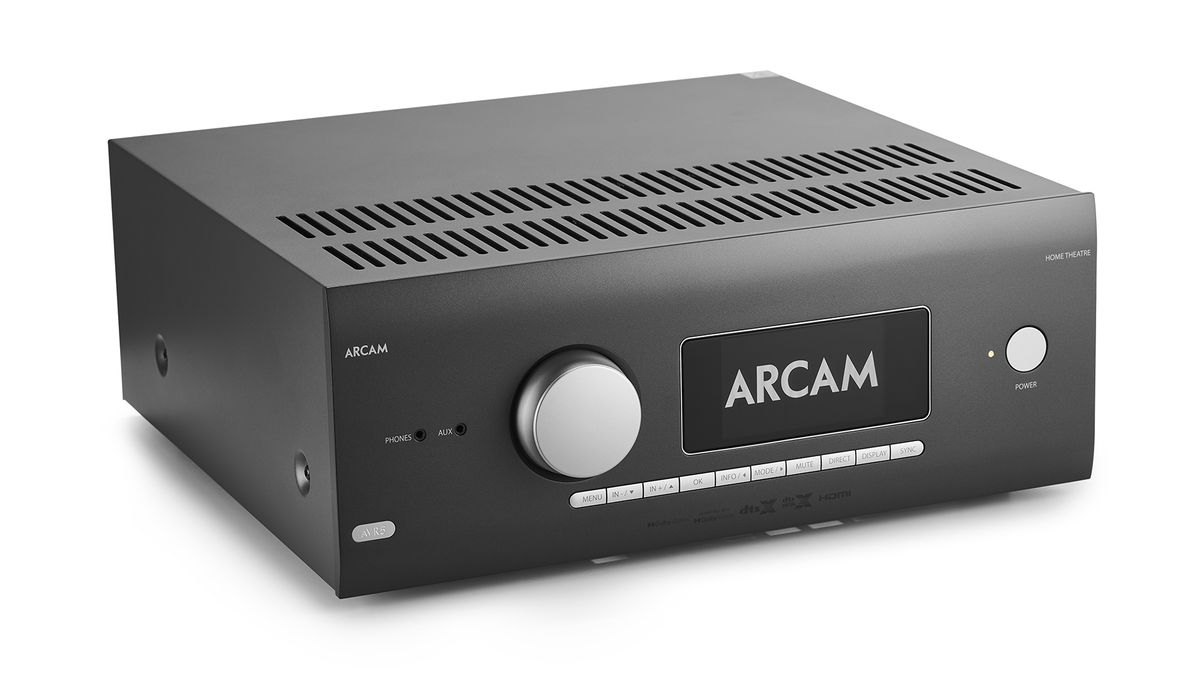What Hi-Fi? Verdict
While it lacks some of the functionality and usability of the competition, the AVR5 delivers an impeccable sonic performance
Pros
- +
Agile and rhythmic
- +
Full, clear delivery
- +
Dynamically authoritative
Cons
- -
Lacks inbuilt calibration
- -
HDMI 2.1 costs extra
- -
Only seven channels of amplification
Why you can trust What Hi-Fi?
As the central hub that connects diverse and demanding home entertainment devices, AVRs, like the Swiss army knife of AV, are often crammed with multi-tasking features to help them tackle any eventuality.
We’re now used to seeing home cinema amps capable not only of handling movies in every flavour of HDR but also the bandwidth demands of next-gen gaming consoles and an excessive quantity of immersive sound formats, as well as the swelling number of amplifier channels they require. On top of all this, users also expect a range of streaming options, room calibration, app control and, ideally, a radio.
So much is asked of overachieving AVRs that when it comes to building a range of products available at different prices, the question for manufacturers of where to trim the fat becomes tricky.
While some brands take the approach of reducing channels of amplification or using cheaper DACs for their more accessible models, Arcam is taking a different tack with the AVR5, its first-ever ‘entry-level’ home cinema amplifier.
Price
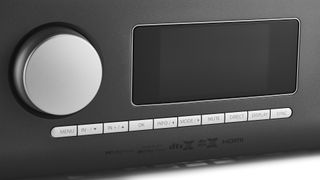
Entry-level is, of course, a relative term. Priced at £2000 / $2000 / AU$3495, the cost of the AVR5 is toward the upper end of the scale for rival manufacturers such as Denon and Yamaha. For Arcam, though, this is budget territory that it's not ventured into before. Above it sit three models: the AVR11 is £2799 (around $3736 / AU$5148), the AVR21 is £3799 (around $5071 / AU$6987), and the AVR31 is priced at £5799 (around $7740 / AU$10665).
Instead of trying to be all things to all people, Arcam says it is putting sound and not features at the core of its AVR range. This means that the AVR5 has the same number of amplifier outputs as the flagship model because seven channels is the maximum number that Arcam believes it can deliver without considerable compromise when compared to the performance of a stereo amplifier.
The entire range also uses identical ESS9026 Pro DACs and shares the same clean aesthetic and build quality, with grey metal casework, a streamer-like 4.3-inch colour TFT screen that displays album artwork, and a single large silver volume dial above a row of function and transport buttons. So when faced with the AVR5, the main question we have is what concessions are being made that make this an entry-level amp, and are they justified by its sonic performance?
Features
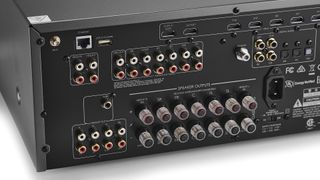
The AVR5 can natively decode 12 channels of Dolby Atmos audio (up to 7.1.4) as well as rival immersive format DTS-X. Dolby Height Virtualisation and DTS Virtual:X are also on board for those who want to simulate height effects without using physical ceiling or up-firing speakers. As the AVR5 sports only seven channels of Class AB amplification, any system larger than 5.1.2 will require the use of a separate power amplifier. Arcam's own options in this regard include the PA410 (£1399 / $1650 / AU$2995), which features four channels of AB amplification, and the two-channel PA240 (£2200 / $2750 / AU$3995) and seven-channel PA720 (£2900 / $3300 / AU$5995), both of which use the company's more premium class-G amplifier circuits, a variation on AB amplification that uses voltage rail switching to improve efficiency.
There are seven HDMI inputs and two outputs with 4K passthrough and HDR10, HLG and Dolby Vision all supported. But, unlike its siblings, the AVR5’s HDMI ports only support HDMI 2.0, with eARC being the only nod towards next-gen HDMI features. This means that those connecting a gaming PC, a PS5 or an Xbox Series X console won’t be able to take advantage of features such as 4K@120Hz gameplay, VRR (Variable Refresh Rate) or ALLM (Auto Low Latency Mode).
As with Arcam’s previous AVRs, it is possible to retroactively upgrade the AVR5 to HDMI 2.1 by sending the unit to an authorised Arcam service centre and paying an unconfirmed additional cost. However, we get the impression that this scheme is more of an affirmation for customers purchasing the AVR5 that it will still be functionally relevant five years down the line, with the expectation being that those who really want HDMI 2.1 features right now will be eyeing up the AVR11 instead.
While a lack of HDMI 2.1 at this price might seem like a cop-out, Arcam's reasoning for not including it as part of its core feature set is that it’s only currently relevant for hardcore gamers, and that’s not likely to change any time soon. As the AVR5 supports 4K signals at up to 60 frames per second, which no movie source currently goes beyond, most users will likely be satisfied with this and happy not to pay for a feature they won’t be using.
Aside from HDMI, there’s also connectivity for wireless streaming courtesy of Apple AirPlay 2, Bluetooth aptX HD, Google Chromecast, and Spotify Connect. The updated Harman MusicLife UPnP app enables playback and control of the AVR5 via Android and iOS, along with providing access to internet radio, music streaming, and podcasts.
With support for MQA audio, subscribers to Tidal HiFi can listen to the highest available audio quality from Tidal Master recordings, while Roon users can use the system’s interface for browsing Qobuz, Tidal, and locally stored music libraries. The AVR5 can also form part of a Roon-driven multi-room system, slotting into existing multi-brand set-ups.
Setting up the AVR5 is a fairly uncomplicated affair thanks to its uncluttered (by AV receiver standards) back panel, with clearly labelled speaker binding posts. There's an array of six digital (four coax, two optical) and six analogue (RCA) audio inputs, as well as optical and analogue outputs. There’s also an aerial connector for an FM/DAB tuner, a USB port and trigger outputs with IR extenders for two zones, along with an RS-232 serial connector and an Ethernet port for wired network connection.
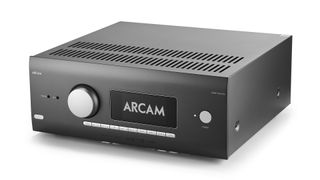
HDMI inputs 7
HDMI outputs 2 (including eARC)
HDMI 2.1 no
Processing 7.1.4 channels
Amplification 7 channels @ 60 Watts
Power 86W (per channel) with two channels driven
HDR formats HDR10, HLG, Dolby Vision
Audio formats Dolby Atmos, DTS:X, Dolby Digital, DD+, Dolby TrueHD, Dolby Surround, Dolby Virtual Height, DTS Neural:X, DTS Virtual:X
Connectivity Ethernet, Wi-Fi, Bluetooth, Airplay 2, Chromecast
While in previous years all Arcam’s AVRs featured Dirac Live Room Correction software, the pay-for-what-you-need approach to the AVR5 means that instead of including Dirac, it provides upgradeable access at an additional cost – and it isn't cheap.
Dirac’s licence tiers start at £247 / $259 / AU$366 for limited bandwidth optimisation of frequencies from 20Hz to 500Hz; while full bandwidth calibration (up to 20kHz) or bass control for a single subwoofer each cost £333 / $349 / AU$491. Finally, there’s an all-in-one package that includes complete bandwidth control and a single subwoofer for £620 / $649 / AU$919.
Owning a Dirac licence is by no means essential, and if you purchase from a dealer that offers installation, Dirac calibration will likely be included. However, if you’re someone who likes fine-tuning or you’re likely to make changes to your set-up, it's important to bear in mind that to make further Dirac adjustments you will need your own licence.
Dirac isn't actually essential, though: you can instead simply calibrate the system manually using a Sound Pressure Level (SPL) meter (there are now decent SPL apps that work fine if you've also got a good phone with a decent microphone, though a dedicated meter is still the way to go if possible) and a tape measure. The AVR5’s main menu includes an internal test tone and options to assign speaker distances, levels, filter slope and crossover points. This is how we approached setup and calibration.
Slightly annoyingly, the AVR5, like the rest of the models in the range, doesn't output its full menu system to the TV or projector to which it's connected. While you can tweak one setting at a time using the included back-lit remote on your main video display, you’re either going to need to be close enough to read the front panel display or connect using an external device.
By far, the best way to perform manual set-up is accessing the GUI via a phone or laptop on the same network by typing the AVR’s IP address into a web browser's address bar. While the Arcam Control app also offers access to the main menu, we could not connect to the app with our device running iOS 15.4.1.
Plenty of AVRs at this price, including those from Denon and Yamaha, include step-by-step calibration software and testing mics and by not offering any automated optimisation process in the AVR5, Arcam gives slightly mixed messages.
On the one hand, it's likely that users purchasing the AVR5 as a first time home cinema amp may not be interested in getting into the nitty-gritty of calibration curves. Equally, though, the less experienced user that the AVR5 is aimed at is more likely to be intimidated by the prospect of setting everything up themselves.
But setting up an AVR manually really need not be daunting. There are plenty of free online guides (including this one) that demystify the process and we actually found that the pared-back, concise layout of both the front panel display and the GUI produced a refreshingly easy to navigate, straightforward and most importantly successful sounding set-up process.
Sound
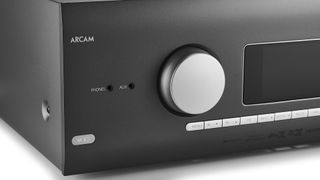
In our manually calibrated 5.1 configuration driving a PMC Twenty5.23 surround speaker package, the AVR5’s nimble but surefooted character is immediately noticeable and irresistibly likeable.
The ’80s classics in the opening of Ready Player One sing out from the soundtrack with resounding rhythmic agility and kinetic energy, an early indication that the AVR5 is a capable amp with music. As Wade’s narration begins there’s a distinct cleanness to the vocal that feels natural and unprocessed with plenty of presence and warmth.
There’s a transparency to the AVR5 that’s rare for a home cinema amp, bringing to life subtle sonic touches that lesser kit leaves unearthed. While its delivery isn’t overly expansive, it has a spaciousness that feels carefully controlled, allowing small details such as changes in the atmospheric sounds, from exterior vantages to inside the vehicles, to rise to the top.
The AVR5 delivers transients with snappy ease, and the action of the race skips along with plenty of weight and heft given to King Kong's destructive rampage. We try the same scene with Denon’s AVC-X6700H, which looms particularly large in this price bracket, and while it has a more robust low end delivery, it sounds somewhat sluggish in comparison to the fleet-footed Arcam.
Despite its levity, the AVR5 puts in a powerful performance when faced with the meaty soundtrack of Dune, with excellent handling of the sudden dynamic shifts from ethereal tinkling sandstorms to giant deadly sandworms. The stillness interspersed with chaos is captivatingly rendered, with a sense of ease and resounding clarity across the board. Even at high levels, the AVR5 doesn’t feel like it's having to work too hard and manages to avoid sounding overly harsh or aggressive.
There’s no shortage of AV products that claim to be equally adept at delivering music and movies, but with its rhythmic deftness, the AVR5 is a very entertaining musical performer. Streaming Balls by Sparks, the frenetic energy of the layers of syncopated synths, jagged guitars and percussion is a propulsive delight. Meanwhile, the repetitive slow build of My Baby’s Taking Me Home, also by Sparks, is delicately handled with its extended subtle crescendo nicely sustained without levelling off.
Swapping to Waking The Witch by Kate Bush, the roominess of the piano sounds authentically acoustic and snatches of sound collage are neatly textured with plenty of low-level dynamic subtlety.
Verdict
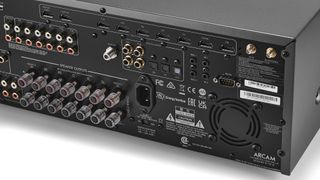
As both the pulse and brain of a home cinema system, AVRs can often fall foul of trying to do too much, leading to compromises being made where it matters most, in sonic performance. But Arcam is so confident in the sound of the AVR5 that it has removed features that it feels don’t have mass appeal in order to bring a hi-fi sensibility to its most affordable home cinema amp.
There are more affordable AVRs that can offer HDMI 2.1, room calibration and over seven channels of amplification, and if those features are important to you then this is definitely not the right product for you. But with its sparkling clarity and agility, the AVR5 makes for an engaging listen across a range of content.
SCORES
- Sound 5
- Build 5
- Features 3
MORE:
Read our review of the Denon AVC-X3700H
Also consider the Yamaha RX-A2A
Read our Denon AVC-X6700H
What Hi-Fi?, founded in 1976, is the world's leading independent guide to buying and owning hi-fi and home entertainment products. Our comprehensive tests help you buy the very best for your money, with our advice sections giving you step-by-step information on how to get even more from your music and movies. Everything is tested by our dedicated team of in-house reviewers in our custom-built test rooms in London, Reading and Bath. Our coveted five-star rating and Awards are recognised all over the world as the ultimate seal of approval, so you can buy with absolute confidence.
-
Bluechicken89 No Tidal Connect support by the looks? Such an odd omission as this would be just the sort of product to appeal to Tidal users who like films.Reply -
DTOVISSI Reply
The Arcam AVR 5 does support Tidal Connect. We were able to add that to our streaming capabilities and pushed that update via OTA. If you own an Arcam AVR5 and want to update it via a USB stick, please visit the Arcam website at https://www.arcam.uk and download the latest Software Release: 1v54_1542Bluechicken89 said:No Tidal Connect support by the looks? Such an odd omission as this would be just the sort of product to appeal to Tidal users who like films. -
Soundria Reply
Tidal/Spotify/Soundcloud apps on tv will do the job for you with digital passthrough ;)Bluechicken89 said:No Tidal Connect support by the looks? Such an odd omission as this would be just the sort of product to appeal to Tidal users who like films. -
Bluechicken89 Yes absolutely. But the user experience of Tidal / Spotify Connect is so much better and you don’t have to turn the telly on to listen to music.Reply -
snot4tots ReplySmokiro said:Interesting, how long will last this arcam before it will break.
Probably a hell of a lot longer than my Onkyo Integra dsp chip that has blown out.....TWICE!! Of which I don't intend to fix again.
